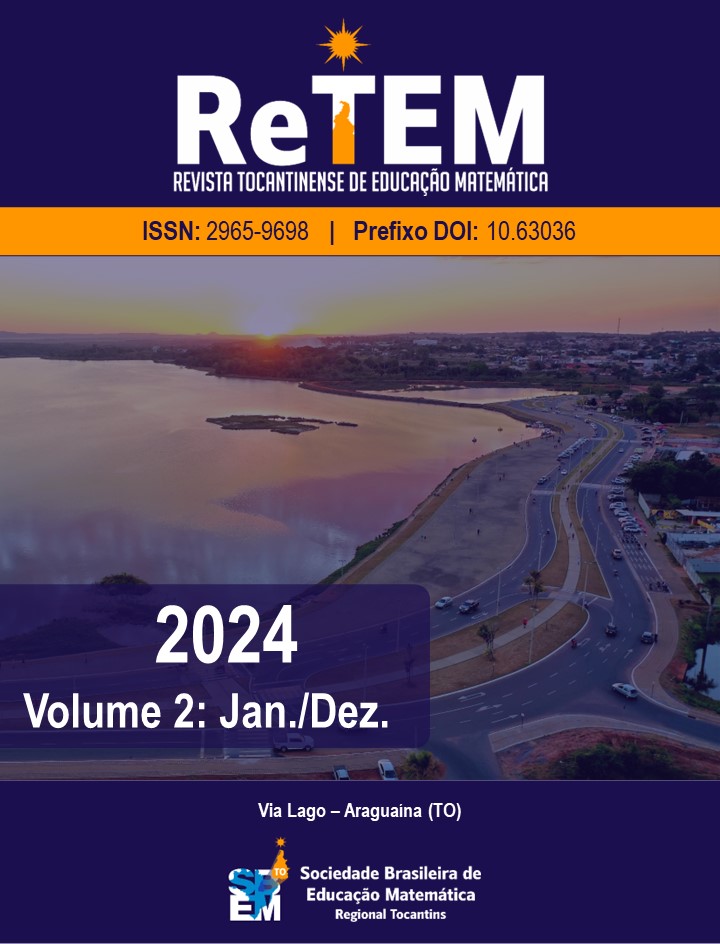MUSIC AND MATHEMATICS - USING MUSICALCOLORIDA FOR TEACHING REAL NUMBERS
DOI:
10.63036/ReTEM.2965-9698.2024.v2.396Keywords:
Mathematics Education, Mathematics and Music, Educational SoftwareAbstract
There are various ways to make school mathematics more appealing to students. With this in mind, the authors of this work sought ways to connect art and mathematics, leading us to music, an artistic medium widely used around the world. Thus, the main goal of this work is to present ways to connect music and mathematics presenting real numbers in a playful and enjoyable way using tools, as well as to introduce musical theory, also relying on theoretical frameworks to support the research. However, finding ways to relate mathematics and music without making it monotonous is not an easy task, which led us to use the MusiCALcolorida software, a multisensory calculator that utilizes colors and sounds to teach real numbers. This software, developed with inclusion goals in mind, was used in workshops applied in two stages: first, with undergraduate mathematics students, and later, with middle school students, as described in the experience reports. We concluded that, with the help of the software, it is possible to unite mathematics and music in a playful way. However, it is essential to enhance its suitability for broader audiences and find ways to address some challenges encountered during its use.
Downloads
Metrics
References
BRASIL. Ministério da Educação. Base Nacional Comum Curricular. Brasília. 2018.
CAÇAPAVA, Priscila. A importância da música. Espaço Musical, 2014. Disponível em: http://www.priscilacacapava.no.comunidades.net/9835-a-importancia-da-musica-9834. Acesso em: 08 nov. 2023.
CASTILHO, Eliane Cristina; TREVISAN, Andreia Cristina Rodrigues; TREVISAN, Eberson Paulo. O jogo PIF racionais como recurso didático para o ensino da temática números. ReTEM – Revista Tocantinense de Educação Matemática, Arraias, v. 2, e24010, jan./dez. 2024. https://doi.org/10.63036/ReTEM.2965-9698.2024.v2.121 DOI: https://doi.org/10.63036/ReTEM.2965-9698.2024.v2.121
CHICOTE, Rosalino Subtil; DEIXA, Geraldo Vernijo. Educ. Matem. Pesq., São Paulo,
v.22, n.1, pp.276-294, 2020.
COLINS, Fabio; OLIVEIRA, Welleton Magalhães de. Educação matemática inclusiva no contexto da educação de surdos. ReTEM – Revista Tocantinense de Educação Matemática, Arraias, v. 2, e24011, jan./dez. 2024. https://doi.org/10.63036/ReTEM.2965-9698.2024.v2.61 DOI: https://doi.org/10.63036/ReTEM.2965-9698.2024.v2.61
CONGREGAÇÃO CRISTÃ. Método de Teoria e Solfejo. 2. ed. São Paulo: Congregação Cristã no Brasil, 2014. v. 1.
D’AMBROSIO, Ubiratan. Educação Matemática: da teoria à prática. Campinas, SP. Editora Papirus, 17a edição, 2009.
GOMES, Camila Franco Alonso; FERNANDES, Luiz Fernando Godinho; ALVES, Patrick do Nascimento; LEANDRO, Shirley Gomes. O Lúdico como Estratégias no Ensino Fundamental II. Revista Gestão Universitária, vol. 10, 2018. Disponível em: http://gestaouniversitaria.com.br/artigos/o-ludico-como-estrategias-no-ensino-fundamental-ii--2. Acesso em: 08 nov. 2023.
MINAYO, Maria C. de S. O desafio da pesquisa social. In: MINAYO, Maria C. de S. (org.). Pesquisa social: teoria, método e criatividade. 28. ed. Rio de Janeiro: Vozes, p. 9-29, 2009.
SAMPAIO, Breno; GUIMARÃES, Juliana. Diferenças de eficiência entre ensino público e privado no Brasil. Econ. Aplic., São Paulo, v. 13, n. 1, p. 45-68, janeiro-março 2009. Disponível em: https://www.scielo.br/j/ecoa/a/5qKVPhTPX3t7R57487t5YsP/#.Acesso em: 08 nov. 2023. DOI: https://doi.org/10.1590/S1413-80502009000100003
Downloads
Published
Métricas
Visualizações do artigo: 545 PDF (Português (Brasil)) downloads: 139
How to Cite
Issue
Section
License
Copyright (c) 2024 Davi Franco Tavares, Eulina Coutinho Silva do Nascimento, Caio Gabriel Moreira Correa da Silva, Sara Silva dos Santos

This work is licensed under a Creative Commons Attribution-NonCommercial 4.0 International License.
Licenciado sob a Licença Creative Commons Attribution-NonCommercial 4.0 International (CC BY-NC 4.0). Esta licença permite compartilhar, copiar, redistribuir o manuscrito em qualquer meio ou formato. Além disso, permite adaptar, remixar, transformar e construir sobre o material, desde que seja atribuído o devido crédito de autoria e publicação inicial neste periódico.


 Português (Brasil)
Português (Brasil)
 English
English
 Español (España)
Español (España)


























